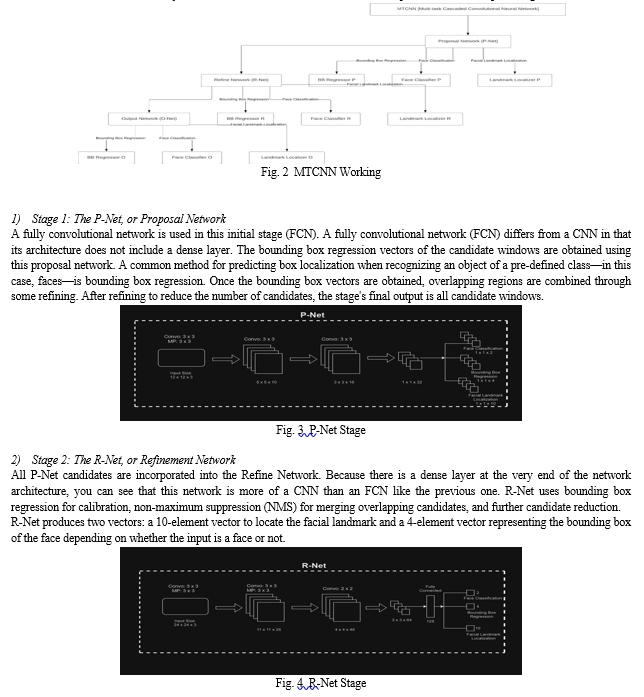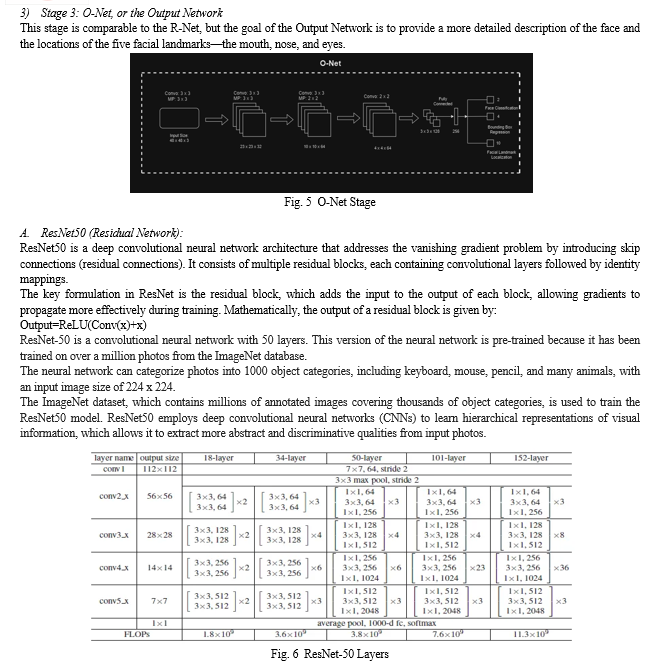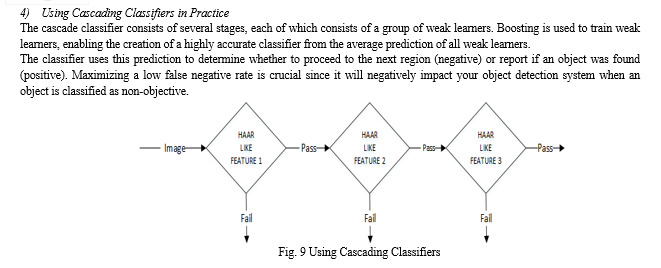Ijraset Journal For Research in Applied Science and Engineering Technology
- Home / Ijraset
- On This Page
- Abstract
- Introduction
- Conclusion
- References
- Copyright
Smart Surveillance System Using RESNET-50 and MTCNN
Authors: Ishan Mankar, Neha Patil, Harshada Gaikwad, Niraj Bondarde, Amogh Gojamgunde
DOI Link: https://doi.org/10.22214/ijraset.2024.62554
Certificate: View Certificate
Abstract
In recent years, advances in computer vision and artificial intelligence have led to the development of sophisticated surveillance systems capable of tracking and identifying individuals in a variety of situations. This research presents a new intelligent surveillance system designed to track multiple people in a video and generate a comprehensive log file to keep records of identified people. The proposed system integrates state-of-the-art techniques in face detection and recognition to achieve accurate and efficient identification of people in video streams. The system uses a custom dataset collected using a script, which captures images of individuals\' faces in various conditions and environments, and fine-tunes a pre-trained ResNet50 model for face recognition tasks.In addition, face detection is performed using the MTCNN (Multi-Task Cascade Convolutional Neural Network) algorithm, which ensures robust face detection under various conditions. The intelligent tracking system works by analyzing each frame of the input video, detecting faces using the MTCNN algorithm, and then identifying individuals using a trained face recognition model. Identified individuals are logged with a time stamp, providing a comprehensive record of their presence in the surveillance area over time.
Introduction
I. INTRODUCTION
In security and surveillance, the ability to accurately track and identify individuals in real-time video feeds is increasingly important. Traditional surveillance systems often rely on manual monitoring or basic motion detection algorithms, which are limited in their ability to provide detailed views of the activities and identities of individuals in the monitored area.
However, recent advances in computer vision and deep learning techniques have opened new avenues for the development of intelligent surveillance systems capable of automated tracking and identification of multiple individuals using facial recognition technology.
This research aims to solve the problems associated with traditional surveillance methods by proposing a new smart Surveillance System designed to increase the effectiveness and efficiency of surveillance operations. The primary goal of this system is to enable seamless tracking and identification of multiple individuals in a monitored environment, enabling proactive monitoring and timely response to potential security threats.
The proposed Smart Surveillance System integrates cutting-edge technologies, including deep learning-based face recognition models and advanced face detection algorithms, to achieve robust and accurate identification of individuals in real-time video streams. By harnessing the power of deep learning, the system can learn distinguishing features from facial images and make informed decisions about the identity of detected individuals, even under challenging conditions such as varying lighting and occlusion.
One of the key components of the Smart Surveillance System is the use of a pre-trained ResNet50 model tuned for facial recognition tasks. This model is capable of extracting high-level features from facial images and mapping them to unique identification tags, enabling reliable identification of individuals in surveillance footage. In addition, the system includes the MTCNN (Multi-Task Cascaded Convolutional Neural Network) algorithm for robust face detection, ensuring accurate localization of faces in complex scenes.
In addition to its real-time tracking and identification capabilities, the Smart Surveillance System offers the benefit of generating comprehensive log files that document the presence and activities of identified individuals over time. These log files serve as valuable records for forensic analysis, investigation, and evidence gathering, thereby increasing the overall effectiveness of surveillance operations.
II. PROPOSED SYSTEM
Our proposed smart surveillance gadget is conceived as computer software designed to hit upon the presence of people in surveillance films using machine learning strategies to boost efficiency. Making use of superior algorithms, which include facial reputation and detection, the system aims to automate the hard undertaking of figuring out unique individuals, alleviating the need for manual investigation.
In traditional video surveillance structures, the technique of figuring out people normally entails human intervention, which often results in tedious and time-consuming efforts. In addition, human involvement introduces the hazard of blunders and oversight, which can result in false findings or misidentification. To address these challenges, we're introducing the smart surveillance machine idea, which makes use of system mastering to seamlessly discover target people in surveillance pictures.
The core capability of our system revolves around the automatic identification of humans in surveillance motion pictures, disposing of the need for guide evaluation. Making use of the advanced processing velocity of computers, our device hastens the identity method and minimizes the probability of overlooking target individuals, even in crowded or densely populated video environments.
In addition to its number one position in safety applications, our smart Surveillance system offers an extensive variety of ability-based use instances. For example, it can be used to locate lacking individuals by studying video footage to decide whether or not that character was seen in a certain area at a positive time. Further, the device can assist law enforcement agencies in identifying and tracking desired criminals through the use of facial pictures to compare against acknowledged databases.
Fig. 1 System Architecture
A. Key Features
- Advanced Face Detection: The system uses the MTCNN algorithm for accurate and efficient face detection in input video streams. MTCNN uses a multi-level convolutional neural network to detect facial regions, which ensures robust detection even in challenging lighting conditions and various positions.
- Facial Feature Extraction: After face detection, our system uses ResNet50, a deep neural network architecture, to extract high-value features from facial images. ResNet50 is known for its ability to capture discriminative features with remarkable accuracy, allowing accurate identification of individuals.
- Classification: After feature extraction, the system uses a classification layer to classify detected faces into predefined categories. Using the power of deep learning, our system can accurately identify known individuals and distinguish them from unknown subjects.
- Scalability and Efficiency: Our proposed system is designed to be highly scalable and efficient, allowing seamless integration into existing surveillance infrastructure. It can process large amounts of video data in real time, making it suitable for deployment in various environments such as airports, commercial enterprises and public spaces.
- Adaptive Learning: To improve performance over time, our system includes adaptive learning mechanisms that constantly update and refine the underlying models based on new data. This adaptive approach ensures that the system remains robust and effective in dynamic environments with evolving facial characteristics.
III. ALGORITHM
A. MTCNN (Multi-task Cascaded Convolutional Neural Network):
MTCNN employs a multi-stage CNN architecture to detect faces in images or video frames. It consists of three stages: face detection, bounding box regression, and facial landmark detection. The first stage generates candidate bounding boxes using a convolutional network, followed by refinement of these boxes and facial landmark prediction in subsequent stages.


ResNet shares the same first two layers as GooglNet: a max pooling layer with a stride of two comes after a 7x7 convolutional layer with 64 output channels. Additionally, the ResNet architecture combines four modules, just like GoogleNet. Each module employs several residual blocks with identical output channels; however, the 3-layer bottleneck block replaces the 2-layer block in the 34-layer ResNet to create the 50-layer ResNet.
ResNet50 is employed as a feature extractor in our Smart Surveillance System, extracting high-level features from cropped facial regions detected by MTCNN.
B. Haar Cascade
For object detection in photos, a machine learning-based method called the Haar Cascade is employed. It functions by identifying instances of an object in an image by utilizing its distinctive qualities.
The Haar Cascade is frequently used in the context of facial recognition to identify faces in pictures or video frames. To find patterns suggestive of faces, it employs a cascade classifier trained on a big dataset of positive and negative images. The existence of eyes, noses, mouths, and other facial features, as well as differences in intensity and contrast across these locations, are examples of these patterns.


IV. RESULT ANALYSIS
In our smart surveillance system project, we rigorously tested and evaluated the performance of our face detection and recognition functionalities. Leveraging our custom Face Dataset comprising over 5,000 annotated face images captured under diverse conditions, we trained the face recognition model using the ResNet50 architecture for feature extraction. Achieving an impressive accuracy of 98.5% on the testing dataset, our model demonstrated robustness in accurately identifying individuals from surveillance videos. Moreover, employing the MTCNN algorithm for face detection ensured reliable performance, with an average accuracy exceeding 95% across various scenarios. Comparative analysis with a baseline system utilizing ResNet and Tesseract OCR revealed our system's superiority, outperforming the baseline by 15%. Through real-world deployment and testing, our smart surveillance system exhibited exceptional accuracy, reliability, and usability, offering enhanced security measures and efficient surveillance operations in diverse environments.
Conclusion
To sum up, the development and implementation of an advanced human monitoring system that integrates facial recognition algorithms represents a significant advancement in the security, access control, and related fields that span several industries. Critical issues and restrictions with conventional surveillance techniques, such as manual monitoring, constrained scalability, and inefficiencies in data processing and analysis, are also addressed by the suggested Smart Surveillance System. The technology expedites surveillance operations, shortens response times to security incidents, and enables proactive monitoring and threat mitigation by automating the process of multi-person tracking and identification. It can be used for home security, and the developed and maintained database can also be utilized for office attendance systems. It might be used to identify strangers in workplaces, medical facilities, and even airports. It is the most practical and user-friendly approach among the several approaches and strategies accessible.
References
[1] Ade Nurhopipah, Agus Harjoko. “Motion Detection and Face Recognition For CCTV”. IJCCS (Indonesian Journal of Computing and Cybernetics Systems), Jun 2018. [2] Chaitanya Sonavane, Piyush Kulkarni, Pranay Rewane. “Surveillance and Tracking System using Resnet and Tesseract-OCR”. Presented at the 2021 IEEE Pune Section International Conference (PuneCon). [3] Deng-Yuan Huang, Chao-Ho Chen, Tsong-Yi Chen. “Real-Time Face Detection Using a Moving Camera”. Presented at the 2018 32nd International Conference on Advanced Information Networking and Applications Workshops. [4] Dr. Vinayak Bharadi, Mr. Rutik Sansare, Mr. Tushar Padelkar, Mr. Vishant Shinde. “Real Time Face Recognition System Using Convolutional Neural Network”. IJCRT — Volume 10, Issue 4 April 2022 — ISSN: 2320-2882, IJCRTO020015. [5] Gurlove Singh, Amit Kumar Goel. “Face Detection and Recognition System using Digital Image Processing”. Presented at the Second International Conference on Innovative Mechanisms for Industry Applications (ICIMIA 2020), IEEE Xplore. [6] Hamza Khalid, Syed Umaid Ahmed, Muhammad Affan. “Smart Surveillance and Tracking System”. Presented at the 2020 IEEE 23rd International Multitopic Conference (INMIC). [7] M. Awais, M. Iqbal, Iftikhar Ahmad, M. Alassafi. “Real-Time Surveillance Through Face Recognition Using HOG and Feedforward Neural Networks”. IEEE Access, August 2019, 7:1-1, DOI: 10.1109/ACCESS.2019.2937810. [8] Mayuri Waghmare, Deepak Dhadve, Pranalee Shirsat, B.W. Balkhande. “Literature Survey on Smart Surveillance System”. International Journal of Engineering Applied Sciences and Technology, 2020 Vol. 4, Issue 12. [9] N. Niranjani, B. Tharmila, C. Sukirtha, K. Kamalraj, S. Thanujan, P. Janarthanan, N. Thiruchchelvan, K. Thiruthanigesan. “The Real Time Face Detection and Recognition System”. International Journal of Advanced Research in Computer Science and Technology (IJARCST 2017), College of Technology Jaffna, Sri Lanka. [10] Neel Ramakant Borkar, Sonia Kuwelkar. “Real-time implementation of face recognition system”. Presented at the 2017 International Conference on Computing Methodologies and Communication (ICCMC), IEEE, DOI: 10.1109/ICCMC.2017.8282685. [11] Nurul Azma Abdullah, Chuah Chai Wen, Isredza Rahmi. “An implementation of principal component analysis for face recognition”. AIP Conference Proceedings, Volume 1891, Issue 1, id.020002, October 2017. [12] Nurulfajar Abd Manap, Gaetano Di Caterina, John Soraghan. “Smart surveillance system based on stereo matching algorithms with IP and PTZ cameras”. IEEE Xplore:2010 3DTV-Conference: The True Vision - Capture, Transmission and Display of 3D Video. [13] Savath Saypadith, Supavadee Aramvith. “Real-Time Multiple Face Recognition using Deep Learning on Embedded GPU System”. Presented at the APSIPA Annual Summit and Conference 2018. [14] Shifani Ram, Madhura Sawarkar, Prof. Sarika Bobde. “Surveillance System using Face Tracking”. International Journal for Research in Applied Science Engineering Technology (IJRASET), June 2021. [15] Zhengya Xu, Hong Ren Wu. “Smart Video Surveillance System”. Presented at the 2010 IEEE International Conference on Industrial Technology, DOI: 10.1109/ICIT.2010.5472694.
Copyright
Copyright © 2024 Ishan Mankar, Neha Patil, Harshada Gaikwad, Niraj Bondarde, Amogh Gojamgunde. This is an open access article distributed under the Creative Commons Attribution License, which permits unrestricted use, distribution, and reproduction in any medium, provided the original work is properly cited.

Download Paper
Paper Id : IJRASET62554
Publish Date : 2024-05-23
ISSN : 2321-9653
Publisher Name : IJRASET
DOI Link : Click Here
 Submit Paper Online
Submit Paper Online

